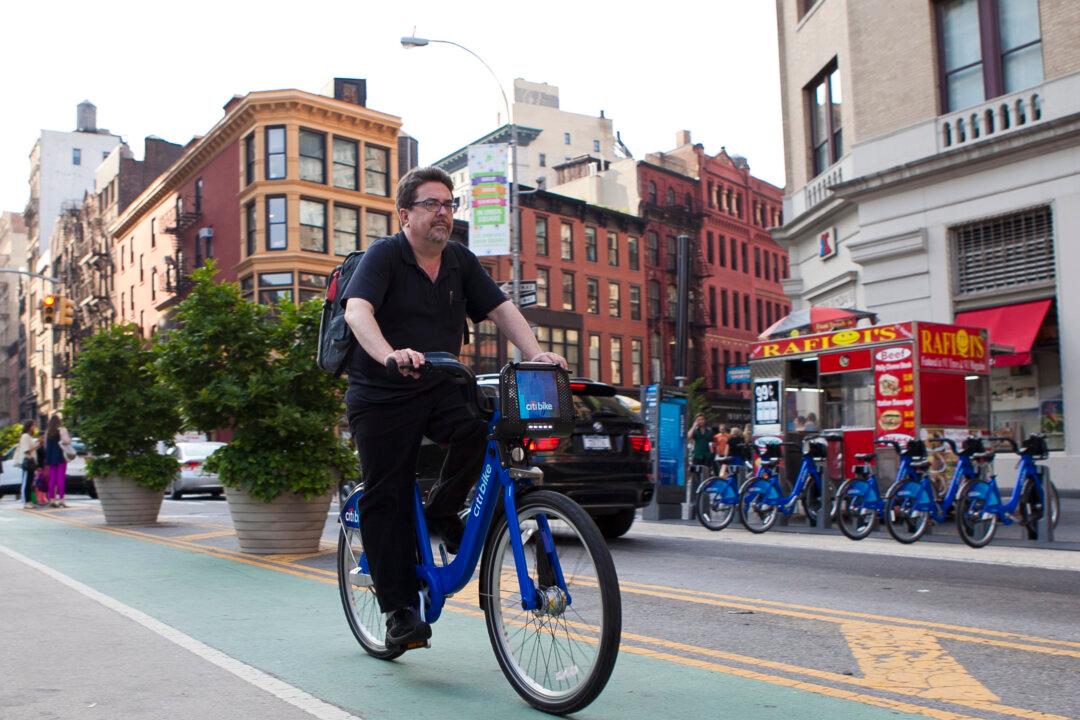NEW YORK—In the last decade the risk for serious injury for bicyclists in New York City has gone down about 75 percent, according to New York Department of Transportation (DOT).
However, the onus is largely on bike riders to be aware and confident when they’re behind the handlebars, said Mayor Michael Bloomberg on May 27 at the launch for the largest-in-the-nation bike share program, Citi Bike in New York.
“We now have an entirely new transportation system without spending any taxpayer money,” Bloomberg pointed out triumphantly.
New York City’s bike share program launched with 6,000 bikes at more than 300 stations, but will soon ramp up to 10,000 bikes and 600 stations.
The size of NYC’s experiment in bike share is significantly larger than the next city Chicago, which will launch a program called Divvy Bike this summer with 4,000 bikes at 400 stations.
According to DOT data, since 2007, the numbers of bikes on key routes have more than doubled, while cycling injuries and fatalities have fallen or remained flat. Some supporters of the program have said that having more bicyclists on the road actually helps with safety because drivers become more acclimatized to watching for bikes.
City transportation officials and staff are emphasizing the safety features of Citi Bikes, such as a stable design and weight that prohibits riding the bikes at high speeds. Other features such as always-on lights, bells, and GPS devices also help with safety.
Information listed on the program’s website also encourages riders to plan a route in advance, and suggests trying out NYC’s 700 miles of bicycle lanes and paths, from shared traffic lanes to car-free greenways. Weaving in and out of traffic is discouraged, while predictable movements are encouraged.
Wearing helmets is also encouraged, although not required. As an incentive, everyone who signs up for an annual bike share membership receives a coupon good for $10 off one helmet at any bike shop in the city. A list of events is also provided where the DOT advertises free helmet giveaways.
“Being super-alert is the key,” said Ken Podziba, president and CEO of Bike New York, a nonprofit that promotes cycling.
“You can’t just space when you’re riding in New York City. I see people riding with headphones, and I think they’re crazy. You need to be able to see, to hear, you need to be alert,” said Podziba.
Podziba, whose organization offers a range of free safety and riding classes for bicyclists, said that it’s important to ride responsibly.
“Fear is your worst enemy as a cyclist,” said Podziba. “We teach people to be predictable—you shouldn’t dart out in the street.”
Podziba pointed out that community watchdogs can do a lot to make things safer for everyone.
According to a New York Police Department officer who was at the Citi Bike launch on Memorial Day, following the rules is important while riding because there is a “whole litany” of things that bicyclists can get tickets for, including illegal turns, riding the wrong way on a one-way street, and riding on the sidewalk.
Podziba suggested that people speaking up when they see traffic violations can help change a culture of unsafe riding by some bicyclists.
“I don’t see enough New Yorkers speaking out against cyclists breaking the rules,” he said, adding “we can’t rely on the police to enforce—I think we need to self-police better.”




